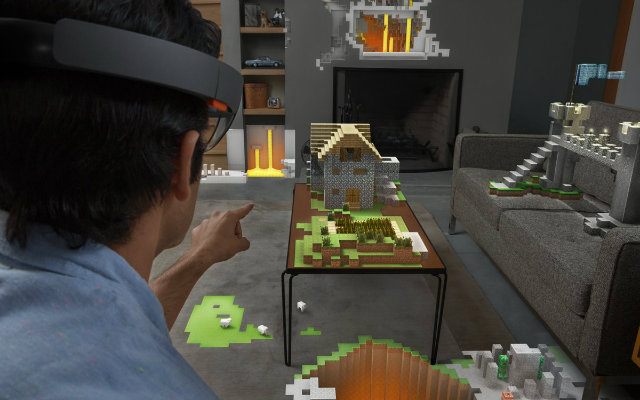
Now that Microsoft has unveiled the brand new Windows 10, there’s a huge buzz surrounding the operating system and, above all, its futuristic feature called Holographic. Of all the announcements Microsoft made during the event, in fact, the company's new virtual reality headset called HoloLens immediately dominated the news. Redmond's giant has officially entered the VR arena, and wants to redefine how companies augment customer experience.
Sci-fi dreamers and futuristic designers have always craved the ability to enter a new reality using technological appendices. These devices, acting as an extension and optimization for human limbs and senses, submerge the user into a parallel world in a 3D personal perspective. All you need to create an amazing experience is an head-mounted headset that blends head tracking and positional tracking using high resolution displays and speed wireless connection.
The Oculus Rift, developed by Oculus VR through Kickstarter crowdfunding, has become the main player in this race to virtual reality. Small and big competitors, though, have promptly entered the game. Samsung is pushing with firm belief - and big budgets - the Gear VR and Google is developing the secret Magic Leap project - a mix between the Rift, Google Glass and the Added Reality Interface (well known to videogame players).
Holographic and HoloLens have all the qualities needed to become the promising Microsoft products that was expected for years. They bring a pretty neat concept, and from day one are already showing a big potential. Via a wire-free headset and virtually implemented environment, users should be able to do all sorts of things, from playing an augmented version of Minecraft in the living room to visiting Mars (thanks to the collaboration between Microsoft and the NASA).
You can easily foresee the consequences of this evolution on digital customer experience. Augmented reality is already playing a vital role in how companies are changing their marketing and engagement strategies. Together with Big Data and the Internet of Things, virtual reality can be the real deal for innovative companies investing in technology. Creating an immersive new level of reality could be the next step in a path full of opportunities.
There are at least three innovative ways to take advantage of virtual reality in DCX, from supporting the customer journey to changing the expected interactions with physical environment.
- Support the Purchase: be it physical products or digital ones, virtual reality - together with wearables and mobile payments - might shape a major revolutions in purchasing. Disruptive technologies change retail customer experience, and the way we buy won't be the same again. Personalized experiences will be more and more relevant, even more in if you are a retail, fashion or luxury business.
- Engage Customers: combining branded physical and digital assets, organizations will be able to engage with customers online and at the point of sale more effectively. Virtual reality headsets are perfect to implement gamification mechanics in your content marketing strategy. Loyalty runs hand-in-hand with innovative experiences memorable for your customer (it's not by coincidence that Microsoft is already adapting HoloLens to work with Minecraft).
- Enhance Experience: stats say that the experience is considered more important than price and product when it comes to the purchase decision. VR is the perfect match for proximity marketing tactics and in-store augmentation. Offering an immersive 3D visual experience is a necessary part of the store improvement, a process that involves the merging of digital and physical environments.
Microsoft HoloLens, just like the Oculus Rift, can be already considered one of the most exciting devices around. Both are enticing; both offer sensational experiences; and both need to overcome new challanges when it comes to thinking through exactly how to use them for your marketing and strategic purposes. But the promise is great: controlling multiple screens and objects, like Tom Cruise in Minority Report, is much closer than you think.
In the Age of the Customer, if you aim at relevance, you need to involve your clients into an omni-channel sensory experience, and VR is just another an ingredient that catalyses the engagement of your customer. To build a strategic advantage to your organization, download the DCX 7-Steps Checklist crafted by Neosperience, with requirements and insights for a successful digital transformation.



 Your magnifing glass to deeply understand your users and increase the value of each relatonship.
Your magnifing glass to deeply understand your users and increase the value of each relatonship. Listen to the voice of your customers deeply to understand what they truly want.
Listen to the voice of your customers deeply to understand what they truly want. The Lead Generation Platform to get leads from anonymous traffic on your website.
The Lead Generation Platform to get leads from anonymous traffic on your website.  Understand the behavior of people in physical spaces and monitor safety requirements.
Understand the behavior of people in physical spaces and monitor safety requirements. The Digital Commerce Platform designed to follow the most modern technological standards..
The Digital Commerce Platform designed to follow the most modern technological standards.. The XReality platform to tell brand and product stories by connecting physical and digital worlds.
The XReality platform to tell brand and product stories by connecting physical and digital worlds. Points, rewards, levels, badges, missions: a world of nudges to nurture your customer community.
Points, rewards, levels, badges, missions: a world of nudges to nurture your customer community. Discover all the other solutions!
Discover all the other solutions!









